text by Satoshi Taito, translation by Lionel Lebigot
The Kama, a weapon of the ashigaru (foot soldiers), developed differently from the Japanese sword, the symbol of the samurai. In the previous article, Hayasaka Yoshifumi sensei, introduced us to the art of Ryûkyû fighting with kama. In this issue, he presents fusôgama-jutsu, the Japanese art of kama fighting, its history, techniques and characteristics.
Development of sickle fighting arts on the battlefields of Japan
The kama is an agrarian tool that farmers use for their daily tasks. It is not difficult to imagine that it was used as a weapon by the low-ranking samurai who were engaged in farming in peacetime and had to stand on the battlefield when war broke out. In addition, some ancient long-handled weapons, such as the halberd, have sickle blades, and these weapons were developed for the purpose of attacking horsemen or cutting the hocks of horses.
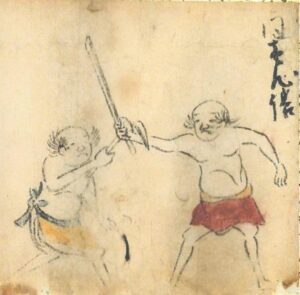
Kama technique as described in the biography of Hongaku Kokki-ryû.
A weapon such as the nagigama (long scythe), capable of attacking and disabling an enemy, was a great help in the midst of the ferocity of a fight. There are several types of long weapons with scythe-like blades that were used on the battlefield, such as the Jûmonji-kamayari (cross-shaped iron spear) of Hôzô’in-ryû.
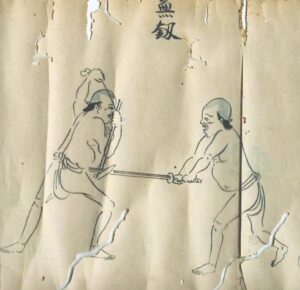
Kama technique as described in the biography of Toda-ryû.
Short handle kama were also used on the battlefield. Most of the battlefields in Japan are located in wet areas, surrounded by river banks and hills. The kama was an important tool for the layout of military positions in such areas. Many of the lower-ranking soldiers who set up the military camp came from agricultural backgrounds and were familiar with the sickle, clearing brush, cutting grass for horse feed and other tasks. Equipped with a sickle, a soldier can sneak behind enemy lines and sabotage installations. If the soldier encounters an enemy, he can immediately change the function of the sickle to a combat weapon.
This article, Hayasaka Yoshifumi shihan of Kingai-ryû-Okinawa kobudô will talk about the Japanese art of sickle fighting.

Kobayashi Kotarô
Hayasaka shihan calls the Japanese art of sickle fighting “fusô-kama-jutsu”. In ancient China, “Fusô” referred to a sacred tree in the eastern sea where the sun rises, in Japan its meaning is different and refers to the Japanese art of sickle fighting. While training in Okinawa-kobudô, Hayasaka-shihan became interested in the history of Japanese martial arts and studied Kensô-ryû jûjutsu under Maehara Seizô-shinhan.。 Through Maehara-shihan, he heard about Kashiwa’ura Kakudô-shihan whom he decided to visit. Unfortunately, by that time, Kashiwa’ura-shihan had already passed away. Initiated to the art of her husband, Mrs Kashiwa’ura gave him densho (fighting manuals) and other ninpô weapons/tools.
Hayasaka Shihan explains how he studied the Japanese art of sickle fighting, Fusô- kamajutsu.
“Kashiwa’ura Sensei’s teacher was Kobayashi Kotarô, who, like Fujita Saiko, was a member of the Kôga-ryû. My shuriken sensei, Satoshi Saito, was a student of Fujita Saiko in his last years. I had the chance to receive the teachings of these two teachers. Afterwards, while pursuing the art of Ryukyu sickle fighting, I continued my own research on the Japanese art of kama fighting.
The Japanese art of kama-jutsu varies in size and shape, from the yari-kama, a sickle attached to a long spear-like handle, to the nisun-kama, small enough, 6cm, to be hidden in the palm. There are different sizes of kama handles: one as long as a wakizashi, one with a hook attached to the base of the sickle, and a long-handled nagigama that is the length of a six-foot pole. Among the koryu (classical currents), there are dôjô that are limited to the teaching of kama alone and others that mix kama and other weapons.
Over the years, Hayasaka-shihan has collected various ancient weapons, of different ages and shapes, and shows us the techniques of various kama.
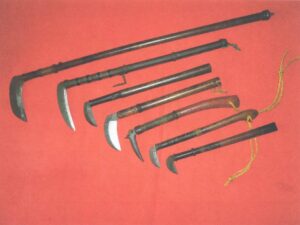
Various period kama belonging to Hayasaka-shihan. From left to right: 5 types of kama for ashigaru, auxiliary equipment.
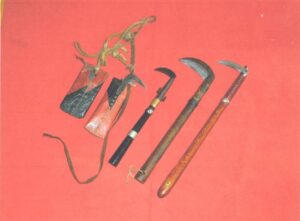
From left to right: 2 types of harness, Shinobi-kama, Jin-kama, Okiri. Okiri would have been used to cut the rope that closed the helmet of the defeated enemy, then decapitate him.
Kama-jutsu techniques transmitted within the Kôga-ryû
Mrs. Kashiwa’ura, an expert in the art of her late husband, taught Hayasaka-shihan kama fighting techniques, among which, i’ai-battô/unshackled/transcended kama techniques. Usually performed solo, they are also practiced with a partner who draws a katana.
In the solo form, the performer sits on the floor with a sickle on his left side. The sickle is gripped with the left hand, then passed to the right hand and finally cut the opponent diagonally. The slicing technique is the same as that of i’ai-battô. Hayasaka-shihan parries his opponent’s attack with his kama, then strikes diagonally to hook with the blade of his scythe. Then he turns the kama and slashes the opponent’s neck.
In kumi kata, Hayasaka-shihan demonstrates the technique of pulling the kama against the opponent’s katana, lowering the blade downwards, and then applying the scythe to the neck to control the opponent. This technique involves using the kama in response to a variety of sword strikes, such as horizontal and vertical strikes.
Jin-kama-jutsu (solo kata and kumite)

Jin-kama-jutsu (solo kata) (1) Sitting on the ground, sickle on the left side of the body.

(2) Hold with the left hand,

(3)and “throw” the jin-kama with the right hand,

(4) Strike from the upper level with the left hand.

Jin-kama-jutsu (kumite) (1) In response to the opponent drawing the katana,
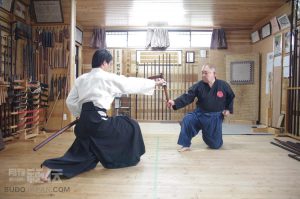
(2) the jin-kama is brought into action,

(3) the opponent’s blade is lowered, and
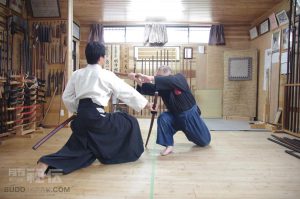
(4) (5) the jin-kama is applied to the neck to control the opponent.

Relationship between nagigama and bôjutsu
The nagigama, a long staff embedded with a kama, is a weapon that can be used in the same way as the other long-handled weapons, bō, of naginata and spear. Grasping nagigama in its lower part is very similar to that of the Muhi-ryû.
Grasp nagigama by its lower end, swing it upwards and strike down the opponent’s katana. In bô-jutsu, it is a technique to strike the katana in order to break it, but with nagigama, the blade of the katana penetrates the chest for a fatal blow. In case the opponent dodges a recoil, his wrist, hand or fingers may be cut. The simple fact of attaching a kama to the end of a bô multiplies its lethal range. Different schools (ryû) teach the use of weapons without irons in peacetime (including training) and attach irons in wartime. If you have the knowledge of the art of the stick, you can master nagigama on the battlefield.
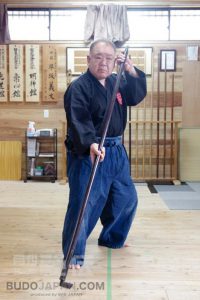
The gedan position of nagigama (①)
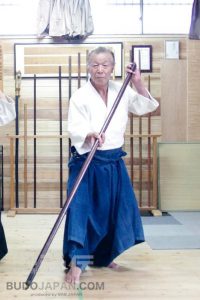
The gedan position of nagigama (①), is similar to that of Muhi-ryû’s bô-jutsu (②).
Nagigama-jutsu (bô of peace and point of war)
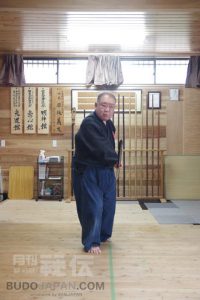


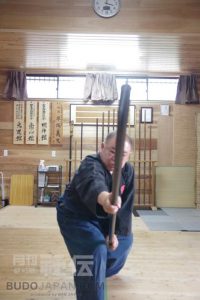
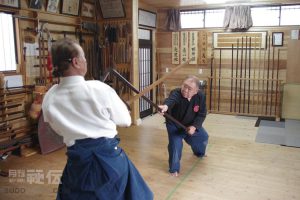
From nagikama gedan-kamae, the opponent’s katana, which is held in a wide swinging stance, is struck downwards.
Short and long distance
The nisungama, small 6cm sickles, more convenient to carry and conceal, have been widely used in assassinations, raids and self-defence.
During some battles kama with inverted blades, fushigama, were used by rank and file soldiers and ninja. Seized in gyaku-te, along the forearm, the soldier or concealed ninja would slice the leg of an enemy. In uke-waza, the attack can be strongly received along the elbow, and on the counter, the blade comes out, lengthening this attack, the ankle or throat of the opponent are prime targets. Kama fencing is particularly effective and is based on movements such as circular movements and elbow strikes.
Fushigama 1
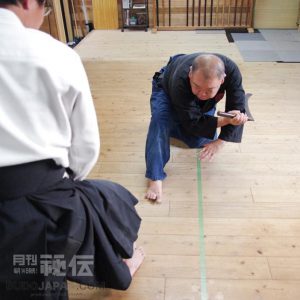
(1) Hold the Fushigama in a reverse grip, with the edge of the blade along the forearm, and

(2)slash the enemy’s legs.
Fushigama 2
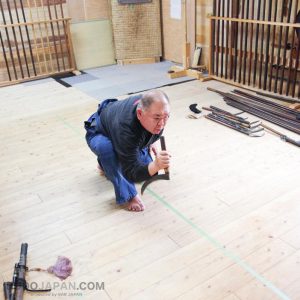
(1) Knee down, and
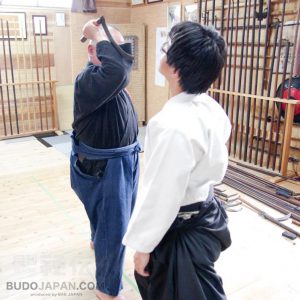
(2) slice the enemy’s throat with an upward elbow.
The “mikazukigama”, crescent blade scythe, is a thick, double-edged weapon, very effective in ambush situations. From a low position, kneeling on the ground, wait for the enemy, and at the right moment, stand up and aim for his throat.
Mikazukigama

(1) Mikazukigama, a crescent-shaped sickle with a double-edged blade, can be used in a variety of ways such as stabbing, and hooking.

(2)From a low position, wait for the enemy, and at the right moment, aim for the throat and stab.
Bashin (bleeding needle) and tsumetogi (nail cutter) are very important tools for the maintenance of horses and their hooves, essential equipment for the mobility of soldiers, from working tools of the grooms, in expert hands, it has become a weapon of war. Hidden in the palm of the hand, tsumetogi became a very effective weapon. Shinobi-kama also called takanotsume (hawk’s claw) was used to subdue an enemy, cutting his throat.
Hidden weapons “ni-sungama/kama 6cm
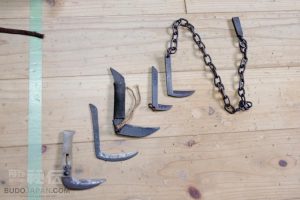
Various kama from tools of life. (From left to right) oritatami-shiki kama, two types of shinobi-kama with fangs, Fundō-tsuki kusarigama.
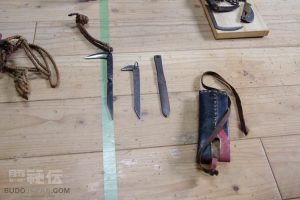
Horse equipment, such as tsumetogi (nail clippers) and bashin (horse needles to drain blood), are also very effective in close combat on the battlefield. The bag on the far right was used to carry this equipment.

Nisungama, hidden in the palm of the hand, becomes a weapon in an emergency.In the case of a nisungama, it is good to use a soft and fluid dynamic.
Ninja weapons “Shinobi-gama/kama(Takeda, Sanada)“
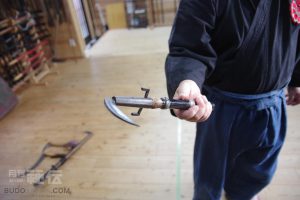
(1) Kagitsuki-shinobi_kama (Shinobi-kama with hook.)
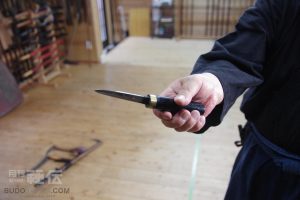
(2) The hilt conceals a dagger.

(3)Grip the blade of the katana between the hooks, and draw the dagger from the hilt and strike.
The staff of a nagigama has the disadvantage of being stiff and cumbersome, the handle of a kama makes it, certainly handy, but short. To overcome these possible disadvantages, the kusarigama was created: a kama to which a chain was added. The chain or the kama can be used to counter-attack effectively.

kusarigama throwing training
On the handle, the attachment of the chain of the different kusarigama is not at the same place. Some kusarigama have their chain attached to the end of the handle and others have their chain attached just under the blade, each with its own use. The kusarigama with the chain attached to the “bladed” end is considered a variant of the chain stick, a combination of a stick and a weight. The chain attached to the end of the handle is turned and struck, and when the time comes, the kama is used to aim at the inside of the wrist and then slit the throat. The one with the chain attached to the other end is used with the chain in the left hand and the kama in the right hand. The weighted chain in the left hand is projected to hook the weapon, to control it, to shorten the ma’ai in relative safety, while the sickle is intended to attack the opponent.
Hayasaka-shihan tells us the following anecdote:
Technique taught by Saito-sensei: on a katana jodan attack, the chain of the kusarigama intercepts the blade, with one step, the attacker closes the gap and captures the weapon and the opponent’s body with the chain.”
Then he adds that Saito-sensei was very keen on this kind of technique which represents the bases of his ryû.
Kusarigama-jutsu
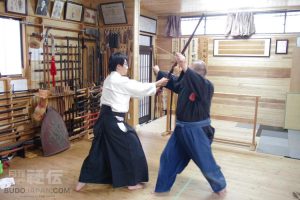
Technique transmitted by Saitô Satoshi-shihan (1)From a jôdan attack, the chain of the kusarigama intercepts the opponent’s blade,
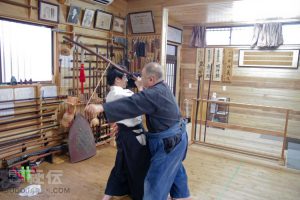
(2)(3)the opponent and the weapon are chained, the opponent is put out of combat.

Concept of use between Okinawan and Japanese kama fighting art.
It is said that there is a difference in concept between the art of kama fighting in Japan and in Ryukyu.
The basic technique of kama techniques in Ryukyu uses two sickles. One kama in each hand, they must act independently in order to attack and defend effectively. In Ryûkyû-kobujutsu, nichôgama, the body dynamics of tûdî, the techniques of kakete and kurite are used, which must be directly applied to the fluidity of the kama.
“I think that the kama used in Ryûkyû-kobudô calls for more circular techniques. Another technique consists in attacking in a low line, unbalancing the opponent and attacking him on the neck as he falls. In this kind of situation, it is necessary to use the dynamics of the tûdî which creates a great power.
Basically, the kama technique is one, in many aspects it resembles kenjutsu or bôjutsu.”
(Editor’s note: Naturally, the soil of Ryûkyû was devoid of iron ore, the peasant, the basic soldier was thus equipped only with wooden tools/weapons. Only the rich Aji had iron weapons (imported). In Japan, the situation was different, iron weapons equipped the armies).
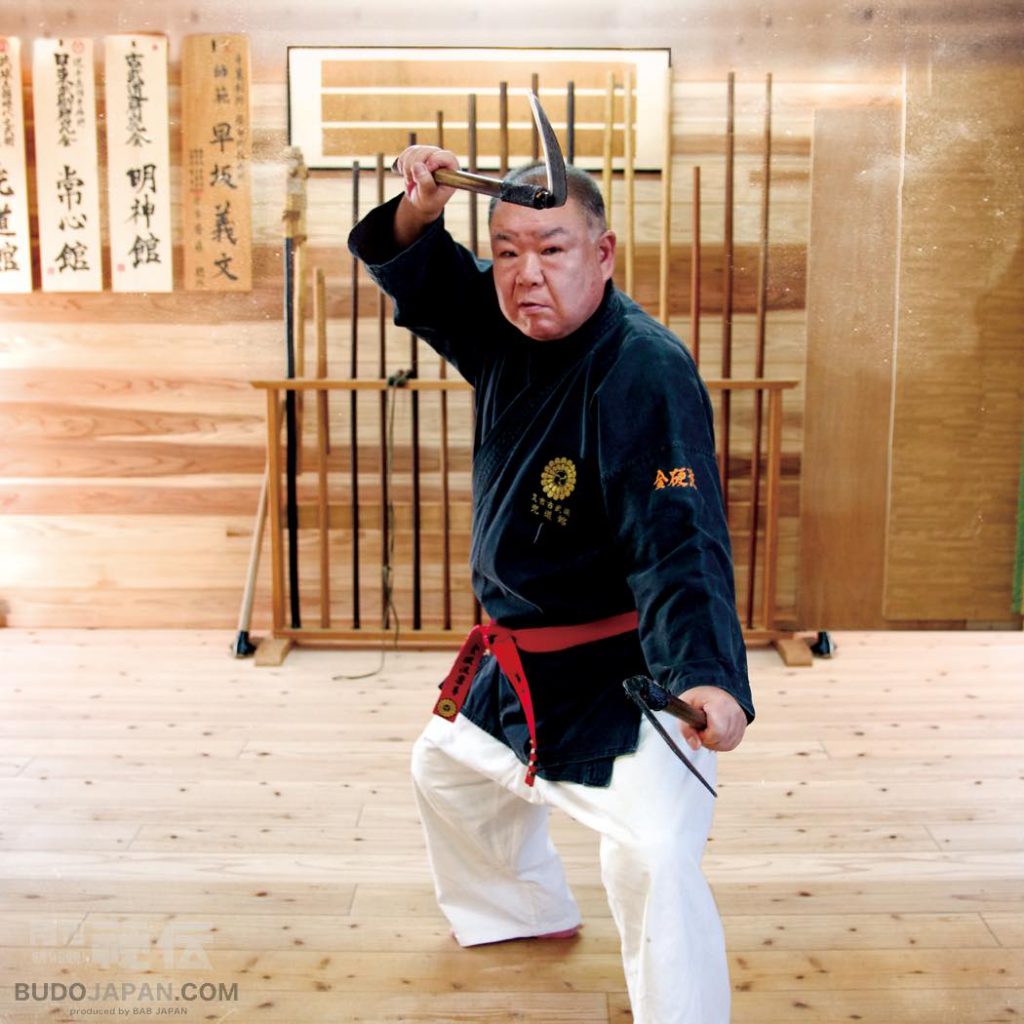
Kama-jutsu of the Ryûkyû Kingdom
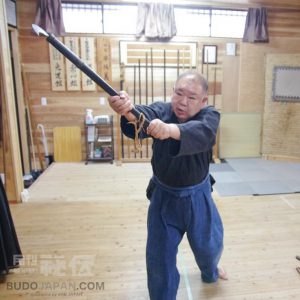
fusogamajutsu of Japan
Ryûkyû Kama nu tî uses the principles and dynamics of tûdî to move the kama, while Fusô kama no te uses the principles of sword fighting, stick fighting, naginata fighting and spear fighting.
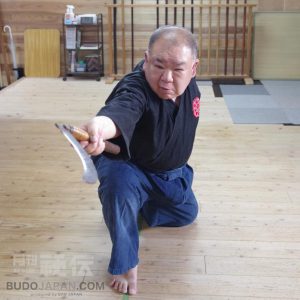
Hayasaka Yoshifumi
Kobudō kenkyūkai Meijinkan
Hayasaka Yoshifumi















